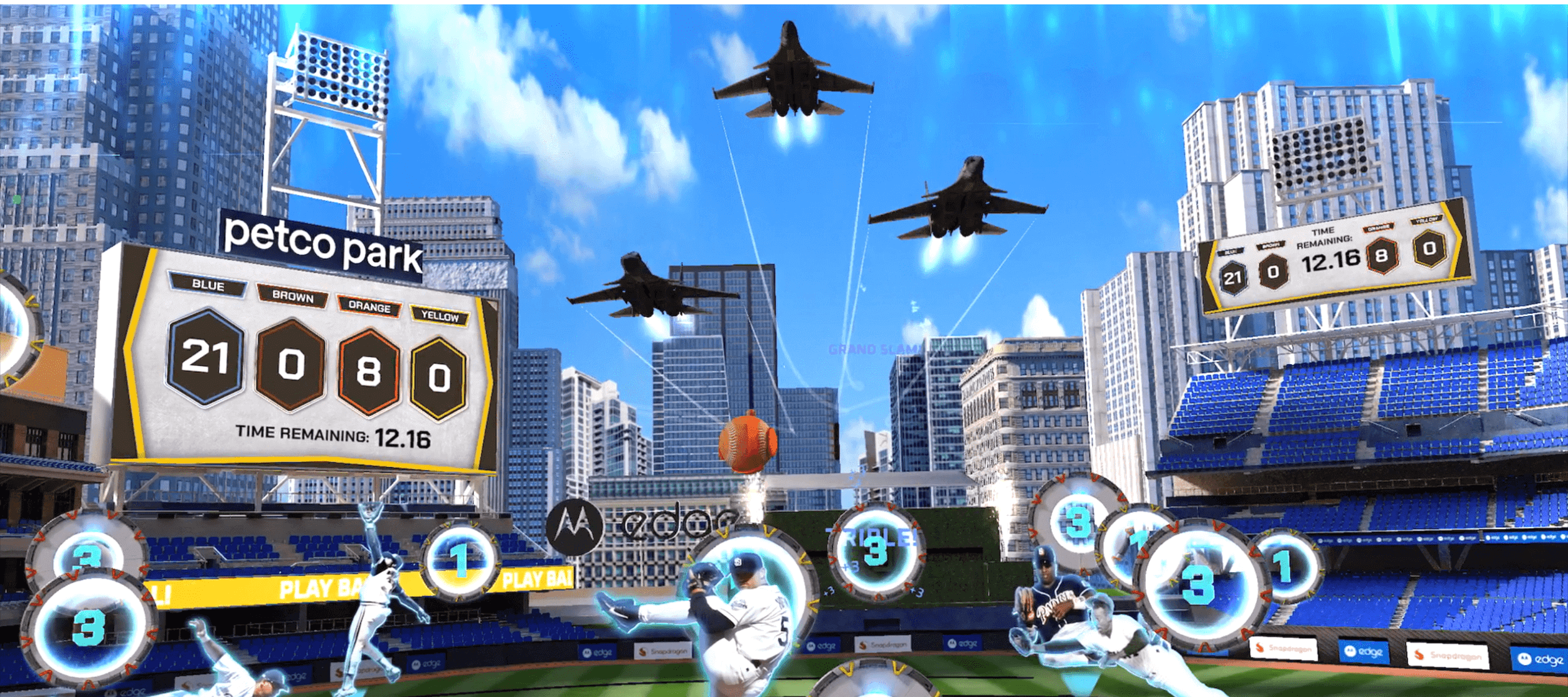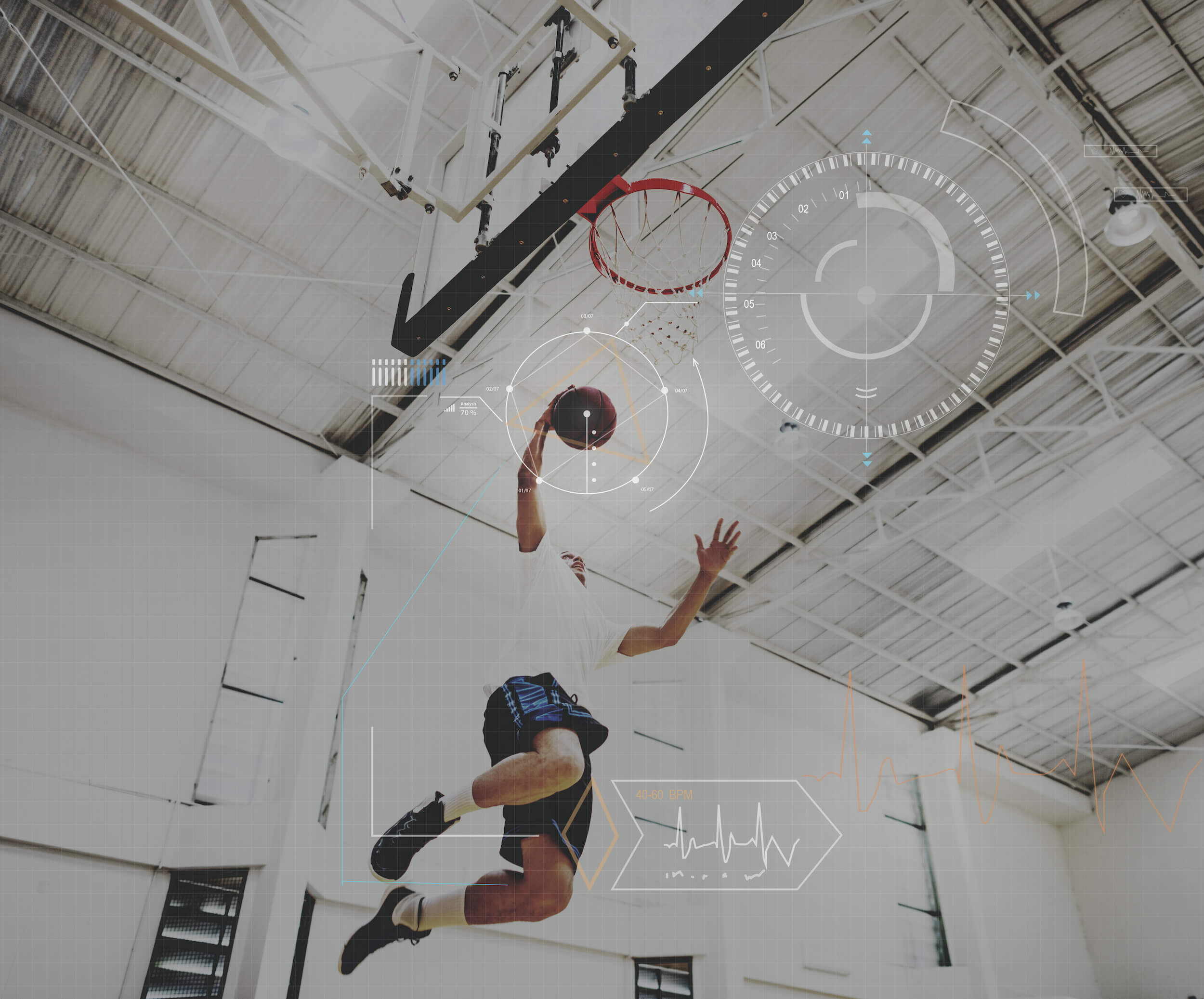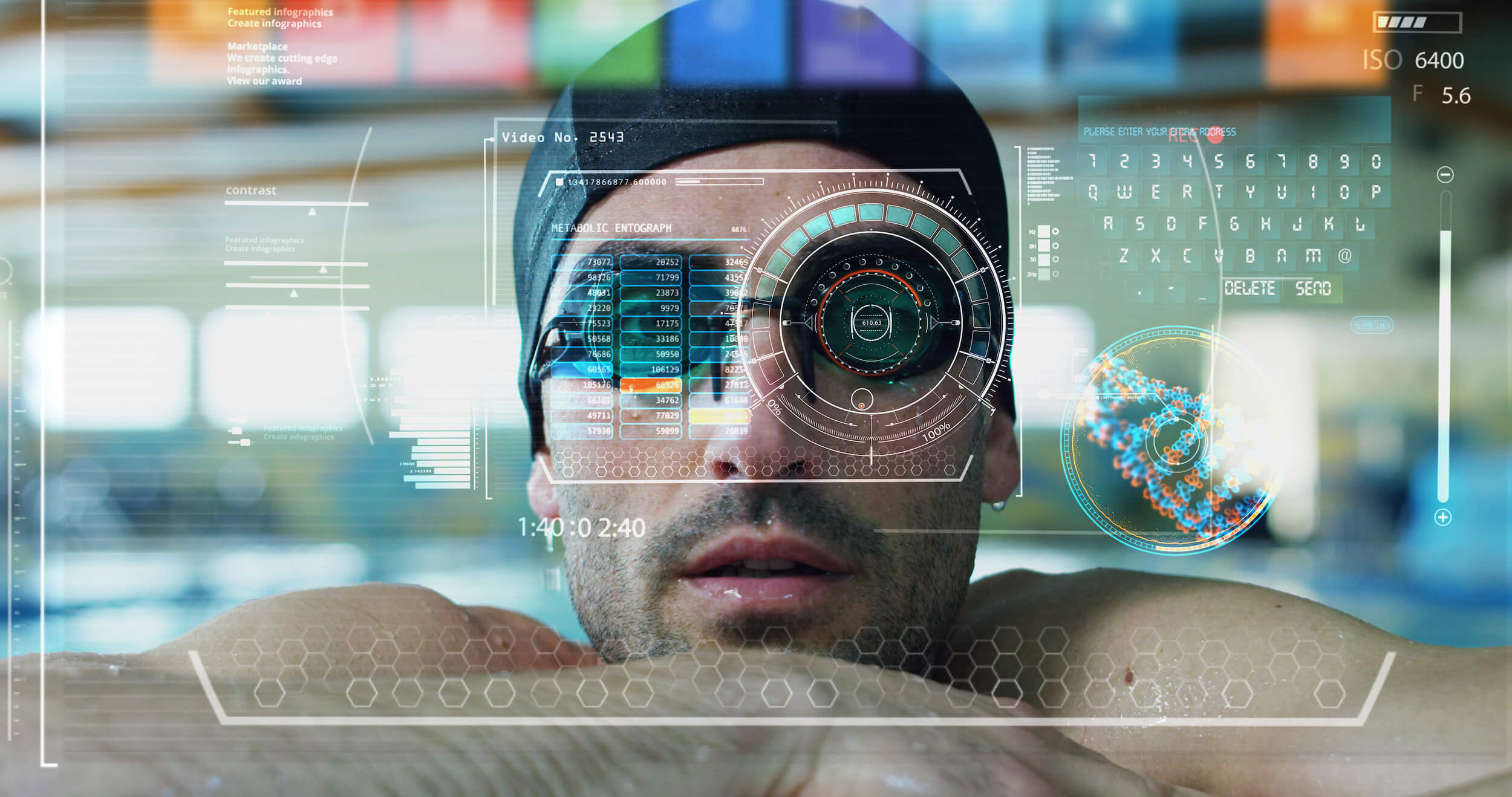
Sports and technology have always gone hand in hand. But now more than ever, consumers expect to engage with their favorite games, matches, and teams in more personal and interactive ways. Recent reports have shown that only 47% of Gen Zers identify as sports fans, compared to nearly 70% of Millenials. In fact, Gen Z respondents were about half as likely as Millenials to watch sports often, but twice as likely to never watch at all. This huge shift is a wakeup call for sports entities, who are facing growing pressure to make participation more current and digitally connected.
Innovation is key for marketing agencies, directors, and strategists to make sports more accessible and culturally relevant for diverse groups of fans. Augmented Reality (AR) has become an essential tool for recapturing lost attention and driving both brand growth and revenue.
Key Takeaways
- Interactive sports marketing allows brands to create engaging and participatory campaigns that appeal to new audiences and tech-savvy generations.
- AR integrations such as real-time data overlays make sports more accessible and culturally relevant to new and emerging fans.
- Virtual experiences increase fan engagement and offer new opportunities for sponsorships, ad revenue, sales channels, and creating sports-related merchandise.
- Immersive experiences can foster emotional connections between fans, brands, and sports heroes, driving long-term brand loyalty and support.
- Athletes can use AR to enhance their performance through virtual simulations and performance analysis. Sponsors can additionally make training simulations available to the public through partner apps.
Let’s chat
Not sure where to start? Book a free strategy call with us to get started! No strings attached.

How is Augmented Reality Used in Sports?
Augmented Reality overlays digital information onto real-world environments, typically viewed through a smartphone camera, AR interface or AR glasses. When strategically employed, it has the power to transform sports entertainment and fan involvement. Clubs, federations, and broadcasters, are creating innovative AR apps to amplify in-game excitement—whether viewers are watching from home or at an event.

AR in Popular Sports
In popular sports like football, basketball, tennis, and soccer, AR can enable users to view virtual representations of team lineups and player profiles. Analysts can use overlays to illustrate potential strategies or to display 3D animations of players from various angles. By superimposing interactive content or 3D graphics onto a live feed, broadcasters can enhance engagement levels drastically.
Broadcaster ESPN uses AR to enhance viewership by amplifying the entertainment level and information value of its sports broadcasting. One sports media report revealed that the integration of augmented reality in sports broadcasts led to 15% higher viewer engagement. During major sporting event broadcasts, it also resulted in a 20% increase in viewer retention.
While watching a game from the stadium is exciting, spectators miss the supporting visual content displayed on TV. But with AR, fans can view information overlays such as player, team, and game stats from the live event location.
In addition, optical tracking, vision processing, and creative graphic technologies such as Hawk-Eye enhance sports officiating. Augmented visualizations of game play eliminate the uncertainty of whether a ball is in or out. Video assistant referees can make decisions quickly—and so can armchair referees from their sofa. Giving sports fans this kind of on-demand, real-time insight creates new value. It also brings fans closer to the action, and strengthens team and brand loyalty.
AR in eSports
Augmented Reality can also revolutionize the way fans view and engage with eSports. Just as with traditional sports, users can gain access to competitive gaming information and AR graphics on TV broadcasts. For instance, at the 2020 AIC Grand Finals, fans could access in-depth game statistics, a 3D map tracking players, and animated avatars showing live match data. Fans could experience an unparalleled level of immersion, personalization, and interactivity, fostering deeper emotional connection to the event.
Thanks to smartphones or AR glasses, viewers could watch their favorite eSports teams compete in a virtual arena overlaid onto their living room floor. They could also view player information in the air above the game and access video replay.
This level of immersion for eSports viewing makes it more accessible and highly appealing, especially to younger demographics. It also opens new revenue streams for developers, teams, and brands through advertising opportunities, virtual ticketing, and premium content offerings.
AR in Extreme Sports
By providing context and creating a more interactive experience, AR can make extreme sports more accessible to those who don’t have a deep understanding of a specific discipline.
For sports like paragliding, mountain biking, or backcountry skiing, AR can provide directional cues, maps, and information about terrain, altitude, and weather conditions. This enables brands to offer safer experiences with better decision making. These features can distinguish a brand as a credible and innovative industry leader.
Experiential agencies for sports brands can enhance the spectator experience by positioning viewers from the athlete’s point of view or elevating the level of spectacle. For instance, the Tokyo’s Air Race X combines real-world flying with augmented reality to create a unique air show experience. Pilots perform aerobatic manoeuvres in actual aircraft at their bases, but the course is fitted to map over Shibuya Crossing. The race is then projected over the actual location, and moves are aggrandized with AR visual effects. This gives viewers an augmented spectacle, with virtual elements like colorful trails, fireworks, and enhancements following the planes’ movements.
Air Race X aims to push the boundaries of what’s possible in aerial entertainment by merging technology and pilot skill. While it provides a novel experience for aviation enthusiasts, it also entices a much broader audience.
Virtual Stadium Tours
Virtual stadium tours offer immersive, interactive, digital recreations of sports stadiums, accessible online or via headworn devices. Providing a 360o view of the facilities—including areas typically off-limits to the public such as locker rooms and VIP sections—these tours allow fans to explore stadiums from the comfort of their own homes.
Virtual tours keep fans connected to their favorite teams and the stadium experience, even when they can’t physically attend games. This can strengthen fan loyalty and broaden reach and inclusivity. A study by the Sports Innovation Journal revealed that virtual arena tours attracted younger demographics in addition to the traditional enthusiasts.
These digital environments also offer new spaces for advertisements and sponsor activations. A sponsor can feature its brand in various parts of the virtual experience, potentially reaching a global audience. And for prospects looking to hire the stadium for events, virtual tours can be a valuable tool for planning without the need for a physical visit.
Virtual Seat Selection and Stadium Navigation
AR can improve fan experiences through practical means as well, like enhancing the process of seat selection and stadium navigation. Providing ticket buyers with a 3D stadium model allows them to virtually explore different sections and views before making a purchase.
Once at the stadium, AR can overlay navigational paths over the real-world environment. It can guide fans to their seats, restrooms, concession stands, food areas, or other points of interest. Easing navigation helps reduce congestion and improves the flow of foot traffic—which is beneficial overall for stadium operations.

A Brown & Wilson study investigated the impact of AR enhancements in sports stadiums on fan experience and attendance rates through a longitudinal analysis before and after the introduction of the AR features. The study revealed that the introduction of interactive displays and AR-guided tours correlated with a significant increase in fan attendance and improved event experiences.
Keep up to date
Sign up to our newsletter for exclusive updates and content, delivered directly to your inbox.
Augmented Reality in Sports Marketing and Advertising
Interactive sports marketing uses various digital technologies to encourage consumers’ active participation in marketing campaigns. This type of marketing goes beyond passive advertising. It incorporates elements that require viewers’ input in order to create a memorable and personalized experience.
Augmented reality can turn advertisements into games, offering rewards such as discounts, free merchandise, or unique experiences. Fans can use AR to virtually try on merchandise like jerseys, hats, or accessories, which they can then directly purchase through integrated eCommerce platforms. Data indicates a massive 94% conversion rate increase when online users are exposed to AR trials along their path to purchase; in addition, return rates decrease by as much as 66%.
To use gamification and interactive elements effectively in sports marketing, it’s important to understand fan demographics, behaviors, preferences, and what motivates them.
Examples of AR in Sports Marketing and Advertising Campaigns
Red Bull—in partnership with RPR—leveraged augmented reality in a campaign to build awareness and anticipation for the Cliff Diving World Series in Boston. Upon scanning QR codes on promotional signage through the city, users saw a real-scale event diving platform appear before them. After the towering virtual structure had grown to full height, users then saw a 3D animated diver somersaulting from the top.
The virtual experience helped amp up excitement for the event, while also effectively conveying the brand’s personality. It helped extend brand awareness to public participants who may otherwise never have been interested or aware.
How to Measure the Success of AR Advertising Campaigns
The most important thing to remember is that AR-driven campaigns are still campaigns, and should be approached in a similar way to other marketing initiatives. Marketing professionals should choose metrics that are aligned with the objectives they are trying to achieve, and ensure they have fully considered where and how the activation will be distributed and promoted.
Some metrics and methods for measuring the success of AR advertising campaigns include:
- User Engagement. The number of times an AR feature is used, average duration of interaction, and repeat usage rate.
- Conversion Rates. The percentage of users who take a desired action after interacting with the AR content. This might include making a purchase, signing up for a newsletter, or downloading an app.
- Social Shares and Virality. The number of times the AR experience is shared on social media. This can be indicative of how compelling the content is.
- Audience Reach. The total number of users who have viewed or interacted with the AR content.
- Customer Acquisition Cost (CAC). The total cost of acquiring a new customer through the AR campaign. This should take into account investment in technology and content development.
- Return on Investment (ROI). The revenue generated from the campaign versus the cost of the campaign.
- Brand Awareness and Perception. Surveys and sentiment analysis can reveal changes in brand awareness and perception before and after the AR campaign.
- Click-Through Rates (CTR). For AR campaigns with clickable elements, the CTR measures how many users clicked on a link or call to action.
- Foot Traffic. For physical locations, an increase in foot traffic due to AR experiences can prove a key metric.
AR and Sports Brand Activations
Passive consumption of sporting events has become a thing of the past. Instead, brands can leverage AR to create unique experiences that turn fans into active participants. Agencies and commercial directors can use AR to forge better connections with fans, bringing them closer to their idols and securing long-lasting consumer retention. Social sharing can play a strategic part in brand growth—72% of US sports fans use social media to follow athletes and sports teams.
A brand can also significantly enhance its connection with an audience by building a community that nurtures a sense of belonging. Through gamification and social interaction, AR-based mobile apps have significantly improved fan engagement. One UK study revealed a 25% rise in fan participation through gamified apps, which allow users to share experiences with friends. These interactive features have boosted user engagement and maintained interest in sports events. Loyal followers can then become brand ambassadors by wearing merchandise and sharing their positive experience with others.

What is the Role of Augmented Reality in Sports Sponsorships?
Sports sponsorships are a great way for brands to activate themselves in the minds of new audiences and create lasting associations. AR can enhance the value of sponsorship deals by creating more ways for sponsors to display brand content.
This could be through virtual stores selling real or virtual goods, in-app purchases, or premium content features. It also presents an opportunity to offer personalized promotions and content. Sponsorship benefits can also extend beyond the game itself. Accessibility to AR experiences long before or after an event can drive fan engagement over a much longer period.
Successful AR-Driven Sponsorship Activations: Motorola & RPR
Motorola approached Rock Paper Reality to develop an Augmented Reality experience for the San Diego Padres baseball team. Featured in the Padres Hall of Fame (HOF) at Petco Park, RPR developed an all-new immersive, multi-player game built with the Motorola edge+, Snapdragon SpacesTM, and Lenovo’s ThinkReality smart glasses.
The game’s objective is to hit balls through virtual floating rings in the stadium. Players use their heads to aim and tap the Motorola edge+ screen to launch a ball. Shots vary in difficulty: the easiest count as singles, while hitting the most challenging distant ring scores a grand slam. Successful shots prompt a celebratory animation.
This AR experience set Motorola and the Padres apart from competitors as forward-thinking brands. It enabled them to not only establish a connection with their target group, but also significantly expand their audiences.
Augmented Reality for Sports Education and Training

AR is making significant strides in sports education and training, offering innovative ways to enhance learning, techniques, game strategy, and improve athletic performance.
Analyzing Athlete Performance
The use of AR in sports education and training can be transformative, offering interactive, engaging, and personalized experiences that enhance the learning process and improve athlete performance.
- Visual Cues and Overlays. AR can provide coaches and athletes with immediate visual feedback on their form and technique by overlaying the correct biomechanical movements over their own as they train.
- Precision Training. Through AR headsets or devices, athletes can see their movements in real time with precision metrics such as angles, distances, and speed, allowing for minute adjustments. The use of proper techniques also minimizes the risk of injury during both training and competition.

Virtual Simulations for Practice
AR tools can assist with tactical training and game strategy in the following ways:
- 3D Play Visualization. Coaches can use AR to simulate game situations and visualize plays in a three-dimensional space. This provides a better understanding for tactical decisions.
- Virtual Opponents. Athletes can practise against virtual opponents, offering a realistic and responsive training experience that mimics real-game scenarios.
- Decision-Making Skills. AR scenarios help athletes develop quicker decision-making skills by simulating high-pressure situations that require real-time responses.
- Skill Acquisition. AR applications can guide athletes through new drills and skills step by step, showing the correct positions and movements to execute.
AR has the potential to democratize access to sports education and elite training techniques. This makes high-quality coaching and performance analysis available to athletes at all levels and in a wider range of locations.
What Is the Future of AR and Sports?
Augmented Reality is poised to be one of the most exciting and transformative influences the sports sector has seen. AR provides a fertile ground for innovation in sports marketing and sponsorships, and the technology offers new avenues for brands to engage with younger consumers. It creates meaningful connections that go beyond traditional advertising.
Rock Paper Reality allows your brand to provide fans and athletes with an unprecedented live experience, in-stadium or at home. Our award-winning team of strategists, designers, creators, and engineers specialize in innovating, developing, and deploying immersive experiences that create value and revenue opportunities. We match the best technology and content styles to your unique brand objectives and budget.
As AR technology continues to mature, its potential applications within sports are limitless. Further your brand with results-driven immersive tech—let’s connect.
Frequently Asked Questions on Augmented Reality and Sports
Can Augmented Reality be integrated into sports merchandise? How does it enhance the fan experience?
Customers can virtually try on clothes and accessories using AR technology, eliminating the need to be in-store to make a purchase. Fans can also scan merchandise like jerseys or scarves with their smartphones to access exclusive content. This might include player interviews, backstage footage, or interactive games, enriching the memorabilia experience.
How does Augmented Reality contribute to inclusivity and accessibility for sports fans with disabilities?
There are many ways AR can enhance accessibility for sports fans with disabilities. These include audio descriptions and real-time information, customizable visual interfaces, accessible stadium navigation, alternative content formats (such as sign language interpretation or subtitles) and more.
How do augmented reality sports experiences differ between live events and at-home viewing?
At live events, AR enhances the in-stadium experience with overlays like stats and navigation. At home, AR transforms the screen into an interactive portal with immersive features like 3D replays and player data, bridging the gap between the audience and the on-field action.
